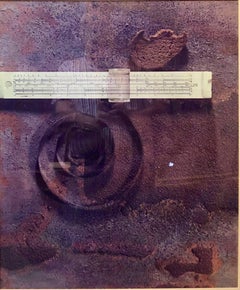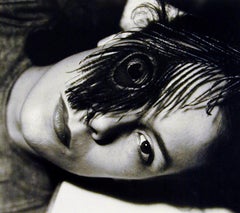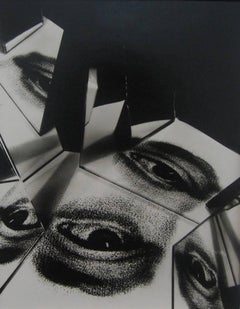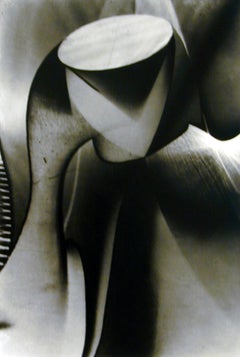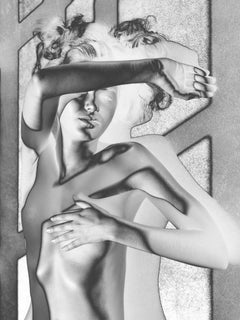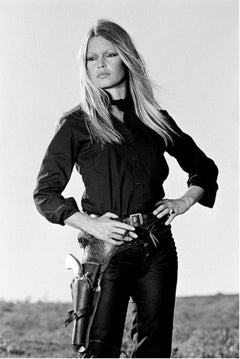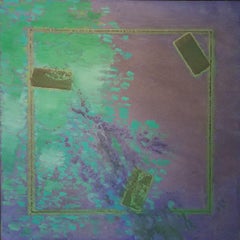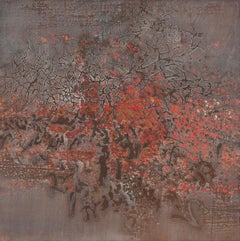Gyorgy Kepes Art
to
3
1
Overall Width
to
Overall Height
to
4
1
1
1
1
3
1
1
1
1
1
1
1
3
1
4
8,227
2,805
1,656
1,313
4
Artist: Gyorgy Kepes
Vintage Large Format Avant Garde Polaroid 20X24 Photograph
By György Kepes
Located in Surfside, FL
Sorry for the reflection on the plexi. In the early 1980s, the Polaroid Foundation invited Hungarian-born painter and photographer György Kepes (1906-2001) to use the 20x24 Polaroid camera. The resulting carefully staged compositions summarize many of his artistic concerns, employing such objects as prisms, flowers, and graphic papers to manipulate the effects of light and form.
György Kepes 1906-2001 was a Hungarian-born painter, photographer, designer, educator, and art theorist. After emigrating to the U.S. in 1937, he taught design at the New Bauhaus (later the School of Design, then Institute of Design, then Illinois Institute of Design or IIT) in Chicago. In 1967 He founded the Center for Advanced Visual Studies at the Massachusetts Institute of Technology (MIT) where he taught until his retirement in 1974. Kepes was born in Selyp, Hungary. His younger brother was Imre Kepes, ambassador in Argentina, father of András Kepes journalist, documentary filmmaker and author. At age 18, he enrolled at the Royal Academy of Fine Arts in Budapest, where he studied for four years with Istvan Csok, a Hungarian impressionist painter. In the same period, he was also influenced by the socialist avant-garde poet and painter Lajos Kassak.
Kepes gave up painting temporarily and turned instead to filmmaking. In 1930, he settled in Berlin, where he worked as a publication, exhibition and stage designer. Around this time, he designed the dust jacket for Gestalt psychologist Rudolf Arnheim's famous book, Film als Kunst (Film as Art), one of the first published books on film theory. In Berlin, he was also invited to join the design studio of Laszlo Moholy-Nagy, the Hungarian photographer who had taught at the Dessau Bauhaus. When, in 1936, Moholy relocated his design studio to London, Kepes joined him there as well.
Kepes was lured to Brooklyn College by Russian-born architect Serge Chermayeff, who had been appointed chair of the Art Department in 1942. There he taught graphic artists such as Saul Bass.
In 1944, he published Language of Vision, an influential book about design and design education. In part, the book was important because it predated three other influential texts on the same subject: Paul Rand, Thoughts on Design (1946), László Moholy-Nagy, Vision in Motion (1947), and Rudolf Arnheim, Art and Visual Perception (1954).
In 1947, Kepes accepted an invitation from the School of Architecture and Planning at MIT to initiate a program there in visual design, a division that later became the Center for Advanced Visual Studies (c1968). Some of the Center's early fellows included artists Otto Piene, Vassilakis Takis, Jack Burnham, Wen-Ying Tsai, Stan Vanderbeek, Maryanne Amacher, Joan Brigham, Lowry Burgess, Peter Campus, Muriel Cooper, Douglas Davis, Susan Gamble, Dieter Jung, Piotr Kowalski, Charlotte Moorman, Antoni Muntadas, Yvonne Rainer, Keiko Prince, Alan Sonfist, Aldo Tambellini, Joe Davis, Bill Seaman, Tamiko Thiel, Alejandro Sina, Don Ritter, Luc Courchesne, and Bill Parker...
Category
1980s Conceptual Gyorgy Kepes Art
Materials
Polaroid
Juliet with One Peacock Feather Eye, Chicago
By György Kepes
Located in Denton, TX
Signed, dated and numbered.
Portfolio Twelve Photographs, No. 13
György Kepes was a Hungarian artist born in 1906. He studied painting at the Budapest’s Academy of Fine Arts. In 193...
Category
1930s Bauhaus Gyorgy Kepes Art
Materials
Silver Gelatin
Eyes, Chicago by György Kepes, 1940, Silver Gelatin Print, Photography
By György Kepes
Located in Denton, TX
Untitled #42 (Eyes, Chicago), by György Kepes is a 4 1/2 x 3 5/8 inch gelatin silver print mounted on 16 1/4 x 13 1/4 inch paper. This photograph is signed and dated in pencil on mou...
Category
Mid-20th Century Modern Gyorgy Kepes Art
Materials
Silver Gelatin
Fluid Patterns
By György Kepes
Located in Denton, TX
Signed, dated and numbered.
Portfolio "Twelve Photographs", No. 13
György Kepes was a Hungarian artist born in 1906. He studied painting at Budapest’s Academy of Fine Arts. In 1937,...
Category
1940s Bauhaus Gyorgy Kepes Art
Materials
Silver Gelatin
Related Items
Spectral (Kings Road) - unique solarized gelatin silver artist print
By Mona Kuhn
Located in San Francisco, CA
In Kings Road (2022) Mona Kuhn lyrically reconsiders the realms of time and space within the midcentury architectural elements of the iconic Schindler House in Los Angeles. Built by Austrian architect Rudolph M. Schindler in 1922, the house was both a social and design experiment and an avant-garde hub for intellectuals and artists in the 1920s and ’30s.
The body of works incorporates chromogenic color prints, reflecting vignettes and materials of the building's emotional architecture, juxtaposition with unique solarized gelatin silver prints capturing traces of an ethereal human presence.
Spectral (2022)
Kings Road: A Rudolph Schindler House
30" x 40" / 76cm x 102cm /edition of 12
15" x 20" / 38cm x 56cm / edition of 12
limited edition solarization photograph printed by the artist + accompanied by signed artist certificate:
artist signature label (8x10")
signed/editioned/dated/titled by the artist + stamped for authenticity
label is placed centered on verso of the mounted print
__________________
About the artist
Acclaimed for her contemporary depictions, Kuhn is considered a leading artist in the world of figurative discourse. Throughout a career spanning more than twenty years, the underlying theme of her work is her reflection on humanity’s longing for spiritual connection and solidarity. As she solidified her photographic style, Kuhn created a notable approach to the nude by developing friendships with her subjects, and employing a range of playful visual strategies that use natural light and minimalist settings to evoke a sublime sense of comfort between the human figure and its environment. Her work is natural, restful, and a reinterpretation of the nude in the canon of contemporary art.
For the past two decades, the Los-Angeles based artist's works have been shown steadily, revealing an astonishing consistency in technique, of subject and of purpose. In 2001, Kuhn’s photographs were first seen by an influential audience during the exhibition at Charles Cowles Gallery in Chelsea, New York. Kuhn’s distinct aesthetic has propelled her as one of the most collectible contemporary art photographers—her work is in private and public collections worldwide and she is represented by galleries across the United States, Europe and Asia.
Kuhn was born in São Paulo, Brazil, in 1969, of German descent. In 1989, Kuhn moved to the US and earned her BA from The Ohio State University, before furthering her studies at the San Francisco Art Institute. She is currently an independent scholar at The Getty Research Institute in Los Angeles. Occasionally, Mona teaches at UCLA and the Art Center College of Design in Pasadena.
Kuhn’s first monograph, Photographs, was debuted by Steidl in 2004; followed by Evidence (2007), Native (2010), Bordeaux Series (2011), Private (2014), and She Disappeared into Complete Silence (2018/19). In addition, Stanley/Barker Editions published Kuhn's Bushes & Succulents in 2018. In 2021, Thames & Hudson published a career retrospective titled Works. Kuhn's most recent publication Kings Road (2022) with Steidl accompanies a multi-dimensional museum traveling exhibition shown in Europe and the US.
Mona Kuhn’s work is in private and public collections worldwide, including The J. Paul Getty Museum, Los Angeles County Museum of Art, The Hammer Museum, Perez Art Museum Miami, Museum of Fine Arts, Houston, and the Kiyosato Museum in Japan. Kuhn's work has been exhibited at The Louvre Museum and Le Bal in Paris; The Whitechapel Gallery and Royal Academy of Arts in London; Musée de l’Elysée in Switzerland; Leopold Museum in Vienna Austria, The Polygon Gallery in Vancouver Canada, Taipei Fine Arts Museum in Taiwan and Australian Centre for Photography. Mona Kuhn lives and works in Los Angeles.
__________________
Solo Exhibitions
2025
Mona Kuhn: Y Tu Desnudo será Un Gran Poema, Museum of Contemporary Art, Malaga, Spain
Mona Kuhn: Kings Road, Lianzhou Museum of Photography, China
2024
Mona Kuhn: The Schindler House, A Love Affair, Galerie XII...
Category
21st Century and Contemporary Contemporary Gyorgy Kepes Art
Materials
Photographic Film, Photographic Paper, Silver Gelatin
$11,000
H 40 in W 30 in
Brigitte Bardot b/w silver gelatin photograph on paper
By Terry O'Neill
Located in Norwich, GB
Terry O’Neill CBE is one of the world’s most collected photographers, with work hanging in national art galleries and private collections worldwide. From presidents to pop stars, he ...
Category
Late 20th Century Contemporary Gyorgy Kepes Art
Materials
Photographic Paper, Silver Gelatin
$10,490
H 24 in W 20 in D 0.1 in
Frosted Window
By Paul Caponigro
Located in Pacific Grove, CA
This vintage silver gelatin print is signed in pencil on the front of the mount. This rare exhibition print in glossy paper (later prints of this image from Portfolio II were made on...
Category
1950s Abstract Gyorgy Kepes Art
Materials
Silver Gelatin
Vintage Silver Gelatin Photograph Jacques Lipchitz Bronze Sculpture Photo Signed
By Adolph Studly
Located in Surfside, FL
Adolph Studly, Swiss born American photographer. His work is kept in the Photographic Archive at The Museum of Modern Art Archives, New York. He was known for his gallery photograp...
Category
1950s Modern Gyorgy Kepes Art
Materials
Photographic Paper, Silver Gelatin
Grace (Kings Road) - unique solarized gelatin silver artist print
By Mona Kuhn
Located in San Francisco, CA
In Kings Road (2022) Mona Kuhn lyrically reconsiders the realms of time and space within the midcentury architectural elements of the iconic Schindler House in Los Angeles. Built by Austrian architect Rudolph M. Schindler in 1922, the house was both a social and design experiment and an avant-garde hub for intellectuals and artists in the 1920s and ’30s.
The body of works incorporates chromogenic color prints, reflecting vignettes and materials of the building's emotional architecture, juxtaposition with unique solarized gelatin silver prints capturing traces of an ethereal human presence.
Grace (2022)
Kings Road: A Rudolph Schindler House
30" x 40" / 76cm x 102cm /edition of 12
15" x 20" / 38cm x 56cm / edition of 12
limited edition solarization photograph printed by the artist + accompanied by signed artist certificate:
artist signature label (8x10")
signed/editioned/dated/titled by the artist + stamped for authenticity
label is placed centered on verso of the mounted print
__________________
About the artist
Acclaimed for her contemporary depictions, Kuhn is considered a leading artist in the world of figurative discourse. Throughout a career spanning more than twenty years, the underlying theme of her work is her reflection on humanity’s longing for spiritual connection and solidarity. As she solidified her photographic style, Kuhn created a notable approach to the nude by developing friendships with her subjects, and employing a range of playful visual strategies that use natural light and minimalist settings to evoke a sublime sense of comfort between the human figure and its environment. Her work is natural, restful, and a reinterpretation of the nude in the canon of contemporary art.
For the past two decades, the Los-Angeles based artist's works have been shown steadily, revealing an astonishing consistency in technique, of subject and of purpose. In 2001, Kuhn’s photographs were first seen by an influential audience during the exhibition at Charles Cowles Gallery in Chelsea, New York. Kuhn’s distinct aesthetic has propelled her as one of the most collectible contemporary art photographers—her work is in private and public collections worldwide and she is represented by galleries across the United States, Europe and Asia.
Kuhn was born in São Paulo, Brazil, in 1969, of German descent. In 1989, Kuhn moved to the US and earned her BA from The Ohio State University, before furthering her studies at the San Francisco Art Institute. She is currently an independent scholar at The Getty Research Institute in Los Angeles. Occasionally, Mona teaches at UCLA and the Art Center College of Design in Pasadena.
Kuhn’s first monograph, Photographs, was debuted by Steidl in 2004; followed by Evidence (2007), Native (2010), Bordeaux Series (2011), Private (2014), and She Disappeared into Complete Silence (2018/19). In addition, Stanley/Barker Editions published Kuhn's Bushes & Succulents in 2018. In 2021, Thames & Hudson published a career retrospective titled Works. Kuhn's most recent publication Kings Road (2022) with Steidl accompanies a multi-dimensional museum traveling exhibition shown in Europe and the US.
Mona Kuhn’s work is in private and public collections worldwide, including The J. Paul Getty Museum, Los Angeles County Museum of Art, The Hammer Museum, Perez Art Museum Miami, Museum of Fine Arts, Houston, and the Kiyosato Museum in Japan. Kuhn's work has been exhibited at The Louvre Museum and Le Bal in Paris; The Whitechapel Gallery and Royal Academy of Arts in London; Musée de l’Elysée in Switzerland; Leopold Museum in Vienna Austria, The Polygon Gallery in Vancouver Canada, Taipei Fine Arts Museum in Taiwan and Australian Centre for Photography. Mona Kuhn lives and works in Los Angeles.
__________________
Solo Exhibitions
2025
Mona Kuhn: Y Tu Desnudo será Un Gran Poema, Museum of Contemporary Art, Malaga, Spain
Mona Kuhn: Kings Road, Lianzhou Museum of Photography, China
2024
Mona Kuhn: The Schindler House, A Love Affair, Galerie XII...
Category
21st Century and Contemporary Contemporary Gyorgy Kepes Art
Materials
Photographic Film, Photographic Paper, Silver Gelatin
$11,000
H 40 in W 30 in D 0.3 in
Poet/Photographer/Andy Warhol assistant Gerard Malanga signed by Jack Mitchell
By Jack Mitchell
Located in Senoia, GA
11 x 14" vintage silver gelatin photograph of Poet/Photographer and Andy Warhol assistant Gerard Malanga photographed in Manhattan in 1970. Signed by Jack Mitchell on the recto. Come...
Category
1970s Pop Art Gyorgy Kepes Art
Materials
Silver Gelatin
$1,275 Sale Price
49% Off
H 14 in W 11 in
"The Glimmer Twins - Mick Jagger" Photography 40x30 in by Charlie Auringer
Located in Culver City, CA
"The Glimmer Twins - Mick Jagger" Photography 40x30 in by Charlie Auringer
Year: 1978
Edition of 50
Medium: Silver gelatin limited edition photographic print on paper
Signed and num...
Category
20th Century Contemporary Gyorgy Kepes Art
Materials
Silver Gelatin
Audrey Hepburn b/w photograph LIFETIME print silver gelatin
By Terry O'Neill
Located in Norwich, GB
Terry O’Neill CBE is one of the world’s most collected photographers, with work hanging in national art galleries and private collections worldwide. From presidents to pop stars, he ...
Category
Late 20th Century Contemporary Gyorgy Kepes Art
Materials
Photographic Paper, Silver Gelatin
$10,490
H 23 in W 16 in D 0.1 in
Architectural Gelatin SIlver Print Vellum Photograph Mark Citret Vintage Photo
By Mark Citret
Located in Surfside, FL
Mark Citret, American, b. 1949.
"Third Story Arches", Fort Point, 1998
Silver gelatin print hand signed and editioned 1/45 in pencil along lower edge.
Published: "Along the Way" Mark Citret, Published Custom & Limited Editions, San Francisco, 1999. Plate #23.
Dimensions: Image area measures 8.25"h x 6.25"w., Frame measures 17.5 x 14.5
Mark Citret was born in 1949 in Buffalo, New York, and grew up in San Francisco. He began photographing seriously in 1968 and received both his BA and MA in Art from San Francisco State University.
He has worked on many photographic projects over the course of his career and continues to do so. From 1973 to 1975 he lived in and photographed Halcott Center, a farming valley in New York's Catskill Mountains. In the mid to late 1980s, he produced a large body of work with the working title of "Unnatural Wonders", which is his personal survey of architecture in the national parks. He spent four years, 1990 to 1993, photographing "Coastside Plant", a massive construction site in the southwest corner of San Francisco. Since he moved to his current home in 1986, he has been photographing the ever-changing play of ocean and sky from the cliff behind his house. Currently, he is in the midst of a multi-year commission from the University of California San Francisco, photographing the construction of their 43 acre Mission Bay life-sciences campus. He has taught photography at the University of California Berkeley Extension since 1982 and the University of California Santa Cruz Extension since 1988, and for organizations such as the Center for Photography at Woodstock, the Ansel Adams Gallery, and Santa Fe Workshops.He was included in the Weston Gallery exhibition NIGHT VISION: PHOTOGRAPHING IN THE DARK works by: Berenice Abbott, Wynn Bullock, Mark Citret, Harold Davis, Robert Frank, Ernst Haas, Chip Hooper, Rolfe Horn, Dale Johnson, Robb Johnson, Michael Kenna, André Kertész, Bob Kolbrener, Paul Kozal, Sally Mann and Jerry Uelsmann and PATTERNS IN ARCHITECTURE works by Ansel Adams, Brett Weston, Edward Weston, Oliver Gagliani, Pirkle Jones...
Category
1990s American Modern Gyorgy Kepes Art
Materials
Vellum, Silver Gelatin
$1,200
H 17.5 in W 14.5 in
Vintage Silver Gelatin Photograph Jacques Lipchitz Bronze Sculpture Photo Signed
By Adolph Studly
Located in Surfside, FL
Adolph Studly, Swiss born American photographer. His work is kept in the Photographic Archive at The Museum of Modern Art Archives, New York. He was known for his gallery photograp...
Category
1940s Modern Gyorgy Kepes Art
Materials
Photographic Paper, Silver Gelatin
Realm (Kings Road) - unique solarized gelatin silver artist printed photograph
By Mona Kuhn
Located in San Francisco, CA
In Kings Road (2022) Mona Kuhn lyrically reconsiders the realms of time and space within the midcentury architectural elements of the iconic Schindler House in Los Angeles. Built by Austrian architect Rudolph M. Schindler in 1922, the house was both a social and design experiment and an avant-garde hub for intellectuals and artists in the 1920s and ’30s.
The body of works incorporates chromogenic color prints, reflecting vignettes and materials of the building's emotional architecture, juxtaposition with unique solarized gelatin silver prints capturing traces of an ethereal human presence.
Realm (2022)
Kings Road: A Rudolph Schindler House
30" x 40" / 76cm x 102cm /edition of 12
15" x 20" / 38cm x 56cm / edition of 12
true size solarized gelatin silver print
printed at artist darkroom in Los Angeles (10 days handling time)
original photograph accompanied by signed artist certificate:
artist signature label (8x10")
signed/editioned/dated/titled by the artist + stamped for authenticity
label is placed centered on verso of the mounted print
__________________
About the artist
Acclaimed for her contemporary depictions, Kuhn is considered a leading artist in the world of figurative discourse. Throughout a career spanning more than twenty years, the underlying theme of her work is her reflection on humanity’s longing for spiritual connection and solidarity. As she solidified her photographic style, Kuhn created a notable approach to the nude by developing friendships with her subjects, and employing a range of playful visual strategies that use natural light and minimalist settings to evoke a sublime sense of comfort between the human figure and its environment. Her work is natural, restful, and a reinterpretation of the nude in the canon of contemporary art.
For the past two decades, the Los-Angeles based artist's works have been shown steadily, revealing an astonishing consistency in technique, of subject and of purpose. In 2001, Kuhn’s photographs were first seen by an influential audience during the exhibition at Charles Cowles Gallery in Chelsea, New York. Kuhn’s distinct aesthetic has propelled her as one of the most collectible contemporary art photographers—her work is in private and public collections worldwide and she is represented by galleries across the United States, Europe and Asia.
Kuhn was born in São Paulo, Brazil, in 1969, of German descent. In 1989, Kuhn moved to the US and earned her BA from The Ohio State University, before furthering her studies at the San Francisco Art Institute. She is currently an independent scholar at The Getty Research Institute in Los Angeles. Occasionally, Mona teaches at UCLA and the Art Center College of Design in Pasadena.
Kuhn’s first monograph, Photographs, was debuted by Steidl in 2004; followed by Evidence (2007), Native (2010), Bordeaux Series (2011), Private (2014), and She Disappeared into Complete Silence (2018/19). In addition, Stanley/Barker Editions published Kuhn's Bushes & Succulents in 2018. In 2021, Thames & Hudson published a career retrospective titled Works. Kuhn's most recent publication Kings Road (2022) with Steidl accompanies a multi-dimensional museum traveling exhibition shown in Europe and the US.
Mona Kuhn’s work is in private and public collections worldwide, including The J. Paul Getty Museum, Los Angeles County Museum of Art, The Hammer Museum, Perez Art Museum Miami, Museum of Fine Arts, Houston, and the Kiyosato Museum in Japan. Kuhn's work has been exhibited at The Louvre Museum and Le Bal in Paris; The Whitechapel Gallery and Royal Academy of Arts in London; Musée de l’Elysée in Switzerland; Leopold Museum in Vienna Austria, The Polygon Gallery in Vancouver Canada, Taipei Fine Arts Museum in Taiwan and Australian Centre for Photography...
Category
21st Century and Contemporary Contemporary Gyorgy Kepes Art
Materials
Photographic Paper, Photographic Film, Silver Gelatin
Brave (Kings Road) - unique solarized gelatin silver artist print
By Mona Kuhn
Located in San Francisco, CA
In Kings Road (2022) Mona Kuhn lyrically reconsiders the realms of time and space within the midcentury architectural elements of the iconic Schindler House in Los Angeles. Built by Austrian architect Rudolph M. Schindler in 1922, the house was both a social and design experiment and an avant-garde hub for intellectuals and artists in the 1920s and ’30s.
The body of works incorporates chromogenic color prints, reflecting vignettes and materials of the building's emotional architecture, juxtaposition with unique solarized gelatin silver prints capturing traces of an ethereal human presence.
Brave (2022)
Kings Road: A Rudolph Schindler House
30" x 40" / 76cm x 102cm /edition of 12
15" x 20" / 38cm x 56cm / edition of 12
limited edition solarization photograph printed by the artist + accompanied by signed artist certificate:
artist signature label (8x10")
signed/editioned/dated/titled by the artist + stamped for authenticity
label is placed centered on verso of the mounted print
__________________
About the artist
Acclaimed for her contemporary depictions, Kuhn is considered a leading artist in the world of figurative discourse. Throughout a career spanning more than twenty years, the underlying theme of her work is her reflection on humanity’s longing for spiritual connection and solidarity. As she solidified her photographic style, Kuhn created a notable approach to the nude by developing friendships with her subjects, and employing a range of playful visual strategies that use natural light and minimalist settings to evoke a sublime sense of comfort between the human figure and its environment. Her work is natural, restful, and a reinterpretation of the nude in the canon of contemporary art.
For the past two decades, the Los-Angeles based artist's works have been shown steadily, revealing an astonishing consistency in technique, of subject and of purpose. In 2001, Kuhn’s photographs were first seen by an influential audience during the exhibition at Charles Cowles Gallery in Chelsea, New York. Kuhn’s distinct aesthetic has propelled her as one of the most collectible contemporary art photographers—her work is in private and public collections worldwide and she is represented by galleries across the United States, Europe and Asia.
Kuhn was born in São Paulo, Brazil, in 1969, of German descent. In 1989, Kuhn moved to the US and earned her BA from The Ohio State University, before furthering her studies at the San Francisco Art Institute. She is currently an independent scholar at The Getty Research Institute in Los Angeles. Occasionally, Mona teaches at UCLA and the Art Center College of Design in Pasadena.
Kuhn’s first monograph, Photographs, was debuted by Steidl in 2004; followed by Evidence (2007), Native (2010), Bordeaux Series (2011), Private (2014), and She Disappeared into Complete Silence (2018/19). In addition, Stanley/Barker Editions published Kuhn's Bushes & Succulents in 2018. In 2021, Thames & Hudson published a career retrospective titled Works. Kuhn's most recent publication Kings Road (2022) with Steidl accompanies a multi-dimensional museum traveling exhibition shown in Europe and the US.
Mona Kuhn’s work is in private and public collections worldwide, including The J. Paul Getty Museum, Los Angeles County Museum of Art, The Hammer Museum, Perez Art Museum Miami, Museum of Fine Arts, Houston, and the Kiyosato Museum in Japan. Kuhn's work has been exhibited at The Louvre Museum and Le Bal in Paris; The Whitechapel Gallery and Royal Academy of Arts in London; Musée de l’Elysée in Switzerland; Leopold Museum in Vienna Austria, The Polygon Gallery in Vancouver Canada, Taipei Fine Arts Museum in Taiwan and Australian Centre for Photography. Mona Kuhn lives and works in Los Angeles.
__________________
Solo Exhibitions
2025
Mona Kuhn: Y Tu Desnudo será Un Gran Poema, Museum of Contemporary Art, Malaga, Spain
Mona Kuhn: Kings Road, Lianzhou Museum of Photography, China
2024
Mona Kuhn: The Schindler House, A Love Affair, Galerie XII...
Category
21st Century and Contemporary Contemporary Gyorgy Kepes Art
Materials
Photographic Film, Photographic Paper, Silver Gelatin
$11,000
H 40 in W 30 in
Previously Available Items
Gyorgy Kepes Green & Purple Geometric Abstraction New Bauhaus Mid-century Modern
By György Kepes
Located in New York, NY
Gyorgy Kepes (1906 - 2001)
Untitled
Mixed media on canvas
48 x 48 inches
Kepes was born in Selyp, Hungary. His younger brother was Imre Kepes, ambassador in Argentina, father of András Kepes, a journalist, documentary filmmaker and author. At age 18, he enrolled at the Royal Academy of Fine Arts in Budapest, where he studied for four years with Istvan Csok, a Hungarian impressionist painter. In the same period, he was also influenced by the socialist avant-garde poet and painter Lajos Kassak, and began to search for means by which he could contribute to the alleviation of social injustice, especially (as he later recalled) "the inhumane conditions of the Hungarian peasantry."
Kepes gave up painting temporarily and turned instead to filmmaking. In 1930, he settled in Berlin, where he worked as a publication, exhibition and stage designer. Around this time, he designed the dust jacket for Gestalt psychologist Rudolf Arnheim's famous book, Film als Kunst (Film as Art), one of the first published books on film theory. In Berlin, he was also invited to join the design studio of László Moholy-Nagy, the Hungarian photographer who had taught at the Dessau Bauhaus. When, in 1936, Moholy relocated his design studio to London, Kepes joined him there as well.
A fortunate consequence of moving to London was that Kepes found his future wife, a 17-year-old British woman née Juliet Appleby, an artist and illustrator. By chance, he saw her on the street, introduced himself, and soon the two began to date. The following year, when Moholy agreed to become the director of a new art school in Chicago (which Moholy dubbed the New Bauhaus), Kepes was invited to join the faculty and to head a curricular area in Light and Color. Kepes asked Juliet to join him. While teaching at the Institute of Design (or New Bauhaus) from 1937 to 1943, Kepes enlarged and refined his ideas about design theory, form in relation to function, and (his own term) the "education of vision." Kepes was lured to Brooklyn College by Russian-born architect Serge Chermayeff, who had been appointed chair of the Art Department in 1942. There he taught graphic artists such as Saul Bass.
In 1944, he published Language of Vision, an influential book about design and design education. Widely used for many years as a college textbook (it had thirteen printings, in four languages), it began by acknowledging Kepes' indebtedness to the Berlin-based Gestalt psychologists, and by asserting that "Visual communication is universal and international; it knows no limits of tongue, vocabulary, or grammar, and it can be perceived by the illiterate as well as by the literate…[The visual arts, as] the optimum forms of the language of vision, are, therefore, an invaluable educational medium". In part, the book was important because it predated three other influential texts on the same subject: Paul Rand, Thoughts on Design (1946), László Moholy-Nagy, Vision in Motion (1947), and Rudolf Arnheim, Art and Visual Perception (1954).
In 1942, Kepes had been one of a number of people (Moholy was another) who were asked by the U.S. Army to offer advice on military and civilian urban camouflage, in the course of which he viewed Chicago from the air. He alluded to this experience in Language of Vision, when he talked about natural camouflage: "The numerous optical devices which nature employs in the animal world to conceal animals from their enemies reveal the workings of this law [i.e., perceptual grouping] of visual organization".
In 1947, Kepes accepted an invitation from the School of Architecture and Planning at MIT to initiate a program there in visual design, a division that later became the Center for Advanced Visual Studies (c1968). Some of the Center's early fellows included artists Otto Piene, Panayiotis Vassilakis, Jack Burnham, Wen-Ying Tsai, Stan Vanderbeek, Maryanne Amacher, Joan Brigham, Lowry Burgess, Peter Campus, Muriel Cooper, Douglas Davis, Susan Gamble, Dieter Jung, Piotr Kowalski, Charlotte Moorman, Antoni Muntadas, Yvonne Rainer, Keiko Prince, Alan Sonfist, Aldo Tambellini, Joe Davis, Bill Seaman, Tamiko Thiel, Alejandro Sina, Don Ritter, Luc Courchesne, and Bill Parker.
While teaching at MIT (where he remained until his retirement in 1974), Kepes was in contact with a wide assortment of artists, designers, architects and scientists, among them Norbert Wiener, Buckminster Fuller, Rudolf Arnheim, Marcel Breuer, Charles Eames, Erik Erikson...
Category
Mid-20th Century Bauhaus Gyorgy Kepes Art
Materials
Canvas, Mixed Media
Nature Hieroglyph
By György Kepes
Located in Dallas, TX
oil and sand on canvas
signed "Gyorgy Kepes / Nature Hieroglyph / 1958" on verso
Category
1950s Modern Gyorgy Kepes Art
Materials
Canvas, Oil
Untitled #32
By György Kepes
Located in New York, NY
Gelatin silver print
Signed and dated in pencil, verso
10 x 8.125 inches, sheet
9.75 x 6.75 inches, image
This photograph is offered by ClampArt, located in New York City.
About the...
Category
1930s Modern Gyorgy Kepes Art
Materials
Silver Gelatin
Glow, 1974
By György Kepes
Located in Wilton Manors, FL
Gyorgy Kepes (1906-2002). Glow, 1974. Oil and sand on canvas, 48 x 60 inches; 50 x 62 inches in custom 22K gold leaf float frame. Excellent condition with no damage or conservation. ...
Category
1970s Abstract Expressionist Gyorgy Kepes Art
Materials
Canvas, Oil
Vintage Large Format Avant Garde Polaroid 20X24 Photograph
By György Kepes
Located in Surfside, FL
Sorry for the reflection on the plexi. In the early 1980s, the Polaroid Foundation invited Hungarian-born painter and photographer György Kepes (1906-2001) to use the 20x24 Polaroid camera. The resulting carefully staged compositions summarize many of his artistic concerns, employing such objects as prisms, flowers, and graphic papers to manipulate the effects of light and form.
György Kepes 1906-2001 was a Hungarian-born painter, photographer, designer, educator, and art theorist. After emigrating to the U.S. in 1937, he taught design at the New Bauhaus (later the School of Design, then Institute of Design, then Illinois Institute of Design or IIT) in Chicago. In 1967 He founded the Center for Advanced Visual Studies at the Massachusetts Institute of Technology (MIT) where he taught until his retirement in 1974. Kepes was born in Selyp, Hungary. His younger brother was Imre Kepes, ambassador in Argentina, father of András Kepes journalist, documentary filmmaker and author. At age 18, he enrolled at the Royal Academy of Fine Arts in Budapest, where he studied for four years with Istvan Csok, a Hungarian impressionist painter. In the same period, he was also influenced by the socialist avant-garde poet and painter Lajos Kassak.
Kepes gave up painting temporarily and turned instead to filmmaking. In 1930, he settled in Berlin, where he worked as a publication, exhibition and stage designer. Around this time, he designed the dust jacket for Gestalt psychologist Rudolf Arnheim's famous book, Film als Kunst (Film as Art), one of the first published books on film theory. In Berlin, he was also invited to join the design studio of Laszlo Moholy-Nagy, the Hungarian photographer who had taught at the Dessau Bauhaus. When, in 1936, Moholy relocated his design studio to London, Kepes joined him there as well.
Kepes was lured to Brooklyn College by Russian-born architect Serge Chermayeff, who had been appointed chair of the Art Department in 1942. There he taught graphic artists such as Saul Bass.
In 1944, he published Language of Vision, an influential book about design and design education. In part, the book was important because it predated three other influential texts on the same subject: Paul Rand, Thoughts on Design (1946), László Moholy-Nagy, Vision in Motion (1947), and Rudolf Arnheim, Art and Visual Perception (1954).
In 1947, Kepes accepted an invitation from the School of Architecture and Planning at MIT to initiate a program there in visual design, a division that later became the Center for Advanced Visual Studies (c1968). Some of the Center's early fellows included artists Otto Piene, Vassilakis Takis, Jack Burnham, Wen-Ying Tsai, Stan Vanderbeek, Maryanne Amacher, Joan Brigham, Lowry Burgess, Peter Campus, Muriel Cooper, Douglas Davis, Susan Gamble, Dieter Jung, Piotr Kowalski, Charlotte Moorman, Antoni Muntadas, Yvonne Rainer, Keiko Prince, Alan Sonfist, Aldo Tambellini, Joe Davis, Bill Seaman, Tamiko Thiel, Alejandro Sina, Don Ritter, Luc Courchesne, and Bill Parker.
While teaching at MIT Kepes was in contact with a wide assortment of artists, designers, architects and scientists, among them Norbert Wiener, Buckminster Fuller, Rudolf Arnheim, Marcel Breuer, Charles Eames, Erik Erikson...
Category
1980s Conceptual Gyorgy Kepes Art
Materials
Polaroid
Eyes, Chicago
By György Kepes
Located in Denton, TX
Signed, dated and numbered.
Portfolio "Twelve Photographs," No. 13
Category
Mid-20th Century Modern Gyorgy Kepes Art
Materials
Silver Gelatin
Untitled
By György Kepes
Located in Wilton Manors, FL
Gyorgy Kepes (1906-2001). Oil, sand and collage on canvas measures 6 x 8 inches; 10 x 12 inches framed. Painting is in excellent condition with no damage or restoration. Signed lower left. Frame has minor water stain on linen, lower right.
Kepes was born in Hungry in 1906. He was not only a painter but also a filmmaker and a writer. Kepes studied at the Royal Academy of Fine Arts in Budapest where he studied painting under Istvan Csok during the 1920's. Kepes was invited to join the design studio of Hungarian photographer Laszo Mohonly-Nagy in Berlin. He then followed Mohonly to London in 1936. It was in London that Kepes met his wife, artist and illustrator, Juliet Appleby. In 1937, he emigrated to the United States.
Teaching:
New Bauhaus in Chicago / late 1937-1943 teaching design
Brooklyn College / 1942 teaching graphic art
School of Architecture and Planning at Massachusetts Institute of Technology / 1947 teaching visual design
Founder of Center for Advanced Visual Studies at MIT / 1967-1974
While teaching at MIT, Kepes' art became abstract. This lead him to pursue an art style known as "new scientific imagery." Kepes continued to teach at MIT until his retirement in 1974. Kepes made numerous pieces in connection to lighting. The first programmable lightwall made by an artist in 1949 on the elevation of Radio Shack in Boston; the kinetic lightwall of the KLM headquarters carried out in 1959; New York Times Square's kinetic wall; Cambridge Harvard Square subway station. His lighting artwork is presented in numerous places including Chicago and San Francisco.
Solo Exhibitions:
2012 Paintings & Photographs 1940s - 1980s - Alpha Gallery, Boston, MA
2008 The art of the light - MODEM Centre for Modern and Contemporary Arts, Debrecen
1984 Light Graphics - ICP - International Center of Photography, New York City, NY
1978 Kepes at the Henry - Henry Art Gallery, Seattle, WA
1958...
Category
1960s Abstract Expressionist Gyorgy Kepes Art
Materials
Oil
Gyorgy Kepes art for sale on 1stDibs.
Find a wide variety of authentic Gyorgy Kepes art available for sale on 1stDibs. You can also browse by medium to find art by Gyorgy Kepes in silver gelatin print, polaroid and more. Much of the original work by this artist or collective was created during the 20th century and is mostly associated with the modern style. Not every interior allows for large Gyorgy Kepes art, so small editions measuring 4 inches across are available. Customers who are interested in this artist might also find the work of and Ida Lansky. Gyorgy Kepes art prices can differ depending upon medium, time period and other attributes. On 1stDibs, the price for these items starts at $2,500 and tops out at $4,500, while the average work can sell for $2,700.
